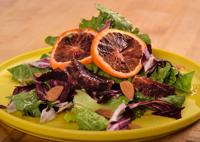In new baking book, holiday fruitcake gets a makeover, with recipes | Food + Living
As a self-described curious cook, I immediately cracked open a review copy of “Fruit Cake: Recipes for the Curious Baker” and said, “Yes, please.” The debut work by Brooklyn-based food stylist Jason Schreiber, “Fruit Cake” defies all notions of those stodgy loaves doubling as doorstops. As the title promises, there is fruitcake in the traditional sense (including the Jamaican Black Cake, below), but that alone would be skimming the surface of Schreiber’s very fruity vision.
His collection of 75 recipes offers something for fruit-loving bakers of all levels, from “blueberry ginger studmuffins” and a single-layered peanut butter and jelly cake (“easy”) to ume-shiso watermelon frozen yogurt cake and bourbon peach kugelhopf (“intermediate”). Schreiber’s wit runs throughout; you’ll find little unexpected zingers in the recipe steps (no spoilers) and his head notes often read like short stories. Clearly, he loves his subject matter, which feels contagious.
I recently caught up with Schreiber via email for the backstory of this delightful collection.

Author Jason Schreiber.
You write in the book’s introduction that you “can’t remember a time when baking wasn’t important to me.” Who or what inspired you at an early age? Did you always know you would land in food?
My Grandma Bim was an enthusiastic baker. Growing up, there was never an occasion that she didn’t have something coming out of the oven (or at least the freezer). There were “Grandma Cookies” for everyday visits, honey cakes and macaroons for the Jewish holidays, and a recipe box full of cards with names like “New Improved Fruit Tart.” Her Yeast Cake, which I’ve adapted for the book, is still one of my favorite recipes.
I definitely had no idea I would land in the food industry when I was a kid. For a while, I was pretty convinced I wanted to be a vet, and then (much later) a graphic designer. I did one of those things for a couple of years — you can probably guess which — before I found my way into the food world. At a certain point it just felt like the natural choice. I was already in a creative field, but I wanted to be making something tangible with my hands, and pastry just felt right.
Why fruit (versus chocolate)? Why cake (versus pie)? A former pastry chef friend always passes on chocolate desserts so that he can have all the fruit.
Don’t get me wrong; I have nothing against chocolate or pie, but it had to be fruit because it lends itself to so many different applications. Fruit can run the gamut from subtle to screaming, and I wanted to be able to show off its myriad dimensions. I’ll admit I’m a bit liberal with my definition of cake in the book, but I wanted to present as many textures and pairings as possible. Plus, I love a pun.

You give space in the front of the book to “a more responsible kitchen.” Talk about what that means and how it applies to home baking.
Our environmental impact begins at the store, where we can choose to purchase items that are minimally packaged, sustainably grown, and — whenever possible — locally produced. Food waste is also the most easily recycled material on the planet; nature invented all the tools and methods to do so eons ago. Composting allows food to decompose in an aerobic environment, preventing the release of methane into the atmosphere, which is up to 34 times as powerful a greenhouse gas as carbon dioxide and a significant cause climate change.
It is deeply upsetting to me that making environmentally responsible purchases is too often a synonym for extravagance, when climate action is so intrinsically connected to our ongoing fight for justice both here at home and across the globe. The solution is to make the act of making environmentally responsible choices mainstream and, therefore, inescapable. It is also crucial during this difficult time that we acknowledge and protect the farm workers — many of whom are undocumented and ineligible for government assistance — whose hard work keeps our kitchens stocked and our tables full, not only during the holidays, but every day of the year.
Thank you for sharing your recipe for Jamaican Black Cake along with the Candied Citrus Peel with LNP | LancasterOnline readers. Talk about your first encounter with this Caribbean holiday classic and what inspired you to include it in the collection.
When I began work on this book, I was inspired to research fruit and cake combinations from all over the world. Black Cake is one of the more famous fruitcakes; its use of burnt sugar syrup or browning — a staple of Caribbean cuisine but less well known elsewhere —intrigued me, and it’s become one of my favorites. Like so many foods, Black Cake has a complicated past, with roots in the traditional British puddings that were brought to the Caribbean Islands during the Colonial period, when largescale production of sugar and rum at the expense of enslaved people’s labor allowed the wealthy to enjoy cakes like this in the first place. Its bittersweet history is part of what makes this cake important to Caribbean people in a way that I as an outsider can’t fully appreciate, though I think we can all agree that it is uniquely delicious.
All recipes from “Fruit Cake” by Jason Schreiber used with permission by William Morrow. All rights reserved. Copyright 2020 byJason Schreiber.

Jamaican Black Cake
Makes about 10 servings.
NOTE
In the book, Schreiber mentions that burnt sugar syrup can be sourced online. I found some via Tippleman’s, a specialty purveyor based in North Charleston, South Carolina. Plan B: Substitute blackstrap molasses.
— Kim O’Donnel
Ingredients:
For the fruit mixture:
- 1/2 cup unsweetened dried tart cherries
- 1/2 cup prunes, roughly chopped
- 1/2 cup orange Candied Citrus Peel, cut into 1/4-inch pieces (recipe follows)
- 1/4 cup dried currants
- 1/4 cup dark rum
For the cake:
- Pan Goo for greasing the pan (recipe follows)
- 1 cup all-purpose flour
- 1 teaspoon baking powder
- 1/2 teaspoon coarse salt
- 1 teaspoon ground cinnamon
- 1/2 teaspoon ground allspice
- 1/4 teaspoon ground cloves
- 1/4 teaspoon freshly grated nutmeg
- 1/4 teaspoon ground mace
- 1/2 cup (1 stick) unsalted butter, softened
- 3/4 cup firmly packed dark brown sugar
- 2 large eggs
- 2 teaspoons pure vanilla extract
- 1/4 cup burnt sugar syrup or blackstrap molasses
- 3/4 cup walnuts, lightly toasted and broken into halves and pieces
- 1/3 cup dark rum, plus additional for aging the cakes
Directions:
In a large bowl, combine the ingredients for the fruit mixture, stirring well to make sure none of it will pass a sobriety test. Cover the bowl and set it aside in a cool, dark place for at least one night or up to 1 week.
Preheat the oven to 300 F with a rack in the center position. Grease a standard 8 1/2-by-4 1/2-inch loaf pan with Pan Goo.
In a small bowl, whisk together the flour, baking powder, salt and spices. Set aside.
Using an electric mixer fitted with the paddle attachment, beat the butter and dark brown sugar on medium-high speed until light and fluffy, about 3 minutes. Scrape down the sides of the bowl and add the eggs, one at a time, mixing well after each addition. Scrape down the bowl again and add the vanilla and burnt sugar syrup. The batter will appear broken at first. Slowly increase the mixer speed to high and continue beating for 3 to 5 minutes to incorporate as much air as possible into the batter. Stop the mixer and scrape down the bowl for what will feel like the eight thousandth time.
Pause to contemplate whoever invented the spatula and remember to thank them later.
Add the flour mixture and mix on low speed until combined, then add the soaked fruit and toasted walnuts, stirring gently by hand to evenly distribute them into the batter. Scrape the batter into the prepared pan and smooth the top with a small offset spatula.
Bake until the cake springs back to the touch and a cake tester inserted into the center comes out clean, about 1 hour and 45 minutes.
Transfer the pan to a wire rack. Pour the rum evenly over the cake, letting it soak all the way down to its nether regions. Allow the cake to cool completely in the pan.
Storage:
It would be a real shame not to age this cake for at least a week by wrapping it in cheesecloth and brushing with more rum. Place the wrapped cake in an airtight container and check on it periodically, brushing the cheesecloth with additional rum whenever it seems dry. A cake stored with this much care (to say nothing of the booze) will last very well.

Pan Goo
Makes about 3/4 cup.
I’ll admit it: I’ve been a parchment fiend, and my careless use has added up to unthinkable amounts of kitchen trash. Keep this mix on hand for a quick lube and easy slide.
Ingredients:
- 1/4 cup neutral oil, such as safflower
- 1/3 cup all- purpose flour
Directions:
In a small container with a lid, whisk the oil and flour together until combined. Brush onto baking pans in place of parchment paper or cooking spray.
Storage:
Keep it in the fridge for a couple of weeks. A month seems like maybe too long.

Candied Citrus Peel
Makes about 1 1/2 cups.
Ingredients:
- 7 to 8 assorted citrus, such as navel oranges, lemons, or limes
- 2 cups granulated sugar
Directions:
Use a sharp knife to remove the peel from the fruit in wide pieces, slicing deep enough to just barely expose the flesh inside. Place the peel on the cutting board with the white side face up and carefully remove about half the pith by slicing horizontally in a sawing motion. Discard the removed pith and save the fruit for juice or snacks.
In a small saucepan, place the peel and add enough cold water to cover. Bring to a boil over medium heat. When it reaches a boil, drain off the water and replace with fresh cold water.
Return to a boil once more and cook until tender, about 10 minutes, then drain again and transfer the peel to a small bowl.
Bring 2 cups water and the sugar to a boil in the saucepan over medium heat, stirring just until the sugar has dissolved. Carefully add the peel to the sugar syrup and adjust the heat to a simmer.
Place a lid on the pot slightly ajar and cook the peels, stirring occasionally, until the pieces are translucent, about 20 minutes.
Remove the pan from the heat and allow the peel to cool completely in the syrup.
Storage:
Candied peel can be stored in its syrup in a covered jar in the refrigerator for up to 1 month, or drained, air-dried, and stored in an airtight container at room temperature for up to 3 months.
![This new series shows that style matters, even if nobody’s looking [Unscripted column]](https://bloximages.newyork1.vip.townnews.com/lancasteronline.com/content/tncms/assets/v3/editorial/b/72/b72e2c68-3bc6-11eb-a494-e718cff62596/5fd392384236f.image.jpg?resize=200%2C296)

